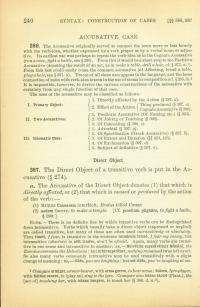386. The accusative originally served to connect the noun more or less loosely with the verb idea, whether expressed by a verb proper or by a verbal noun or adjective. Its earliest use was perhaps to repeat the verb idea as in the Cognate Accusative (run a race, fight a battle, see § 390). From this it would be a short step to the Factitive Accusative (denoting the result of an act, as in make a table, drill a hole, cf. § 273, Note 1). From this last could easily come the common accusative (of affecting, break a table, plug a hole, see § 387.a). Traces of all these uses appear in the language, and the loose connection of noun with verbidea is seen in the use of stems in composition (cf. § 265.3).1 It is impossible, however, to derive the various constructions of the accusative with certainty from any single function of that case.
The uses of the accusative may be classified as follows.
| I. Primary Object: | 1. Directly affected by the Action (§ 387.a) | |
| 2. Effect of the Action | Thing produced (§ 387.a) Cognate Accusative (§ 390) |
|
| II. Two Accusatives: | 1. Predicate Accusative (Of Naming etc.) (§ 393) | |
| 2. Of Asking or Teaching (§ 396) | ||
| 3. Of Concealing (§ 396.c) | ||
| III. Idiomatic Uses: | 1. Adverbial (§ 397.a). | |
| 2. Of Specification (Greek Accusative) (§ 397.b) | ||
| 3. Of Extent and Duration (§ 423, § 425) | ||
| 4. Of Exclamation (§ 397.d) | ||
| 5. Subject of Infinitive (§ 397.e) | ||

